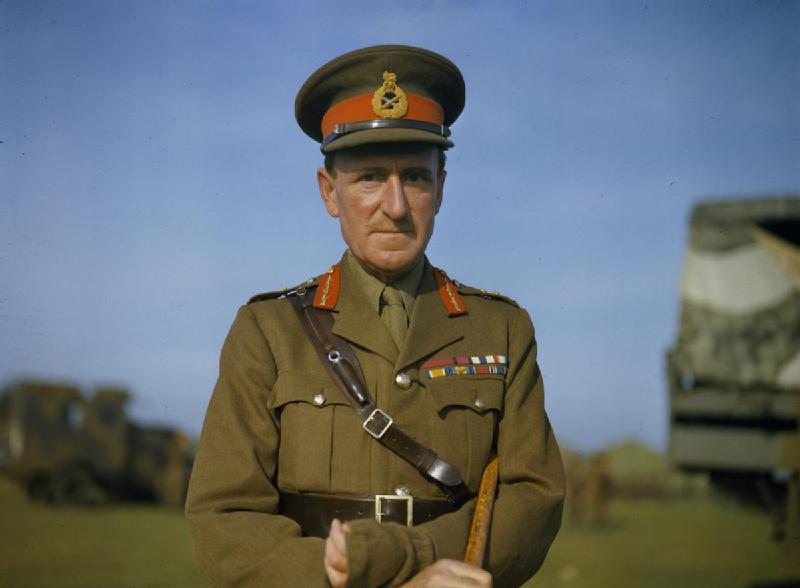
The Commander in Chief Home Forces, General Sir Bernard Paget, October 1942 Half length portrait of General Sir Bernard Paget, Commander in Chief, Home Forces.
General Sir Bernard Paget talks to a parachute jumping instructor at Ringway. Air Marhal Sir Arthur Barratt is in the centre and Group Captain Maurice Newnham on the extreme right.
The son of a bishop and educated at Shrewsbury and RMC, Sandhurst, Paget was commissioned in the Oxfordshire and Buckinghamshire Light Infantry in 1907. His First War service was in France, where he was five times mentioned in despatches, awarded the MC in 1915 and admitted to the DSO in 1917. Twice wounded, he was never fully to recover the use of his left arm.
Married in 1918 and a graduate of the Staff College, Camberley, in 1920, Paget shone as a teacher of officers and trainer of troops. A lieutenant colonel in 1925, he was an instructor at Camberley 1926–1928 and, after attending the Imperial Defence College in 1929, served on the instructing staff at the Staff College, Quetta, 1932–1934, followed by a two-year spell at the War Office. Commander of the Quetta Brigade and Baluchistan District 1936–1937, he was promoted major general and appointed Commandant of the Staff College, Camberley, in 1938.
GOC of 18th Division 1939–1940, Paget was ‘summoned at a moment’s notice’ (DNB) in April 1940 and sent with his divisional staff to Åndalsnes in Norway. There, installed as head of SICKLEFORCE, he supervised the successful withdrawal and evacuation of British troops. It took less than a week, but his ‘fine feat of arms’ was rewarded with him being appointed CB.
Appointed CGS Home Forces in June 1940, Paget, a ‘large-nosed, dark-haired, sharp-tongued’ man, who could be ‘extremely funny when he chose’ (Fraser, 2002, 140), was promoted lieutenant general the following year. Made C-in-C South Eastern Command, his troop-training expertise came to the fore and his hot temper, elephantine memory and capacity to devote ‘half and hour’s discussion . . . over where a comma should be placed in a sentence’ (Pyman, 1971, 61) made him something of a legend. His brusqueness of manner, ‘that seemed to combine rudeness and bad temper’ (Hamilton, 1982, 516), was put down to the continuous pain he suffered from his war wound. Eager to make training more realistic, he was probably the commander most responsible for instituting battle-drill. Tipped to succeed Dill as CIGS in December 1941, Brooke, ever one to elide his own interests with those of the state, regarded the prospect as ‘a tragedy [and] a definite step towards losing the war’ (Danchev & Todman, 2001, 198).
Appointed C-in-C Home Forces in December 1941, Paget was knighted the next year. It was probably he who was most responsible for preparing the army for the opening of the second front in Europe. Appropriately appointed C-in-C 21st Army Group in June 1943, he was, just as appropriately, sidelined that December when Montgomery, who described him as having ‘very rigid ideas’ (Alanbrooke, 6/2/22, LHCMA), was summoned from Italy to assume that command. Always the bridesmaid, and ‘bitterly disappointed at not being allowed to use in battle the weapon he had shaped and termpered’ (Grigg, 1948), he was appointed C-in-C Middle East Force and divided his time over the rest of the war between Cairo and Baghdad. His younger son was killed in action in Holland in 1945.
Retired from the army in 1946, Paget enjoyed what appears to have been a fantastically busy retirement. Principal of Ashridge College, a Conservative-oriented adult education centre promoting ‘good citizenship’, he resigned after a row with the governors. He was Colonel Commandant of the Oxfordshire and Buckinghamshire Light Infantry 1946–1955 and Colonel Commandant of the Reconnaissance and Intelligence Corps 1943–1952. Sometime National Chairman of the Forces Help Society, he was a longstanding Vice-President of the Royal Commonwealth Society for the Blind. Much decorated by foreign governments, he was a Freeman of the City of Cork and DL for Hampshire from 1952. He died at his home in Petersfield at the age of 73.